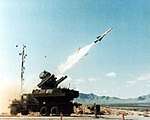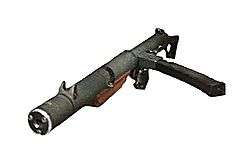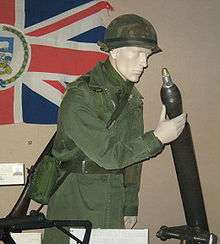Weapons of the Falklands War
These are some of the key weapons of the Falklands War used by both sides.
Anti-ship missiles
The Exocet is probably the most famous weapon of the war, sinking two British ships and damaging a third. Operated by both sides the missile was used by the Argentine Navy either air launched from Dassault Super Étendard jets and from an improvised land launcher.
- See main article Exocet.
The Sea Skua was a British light anti-ship missile, fired from Lynx helicopters, its warhead is only 20 kg compared with the Exocet's 165 kg. However, hits from three Sea Skua missiles badly damaged the Argentine ARA Alferez Sobral.
- See main article Sea Skua.
The AS.12 was a French built light anti-ship missile, fired from Westland Wasp helicopters. Like the Sea Skua, its small 28 kg warhead meant that it could not destroy ships outright; however, it could disable smaller vessels. On 25 April 1982 it contributed towards damaging and disabling the Argentine Submarine the ARA Santa Fe. A total of nine missiles were fired at the submarine trapped on the surface by anti-submarine torpedoes circling just under the hull. Of the missiles fired four hit, four missed and one failed to launch. Two of the missiles that hit the target failed to detonate on impact, instead punching a hole through the slender conning tower and exploding on the far side.
- See main article AS.12.
Surface-to-air missiles
Sea Dart was the British naval medium-range surface-to-air missile. It proved unable to engage low-altitude targets, such as Argentine A4 Skyhawk aircraft and Exocet missiles. However, it did achieve several long-range kills.
Sea Wolf is a British naval short-range low-altitude surface-to-air missile, used to complement the longer-range Sea Dart. It proved capable of engaging low-flying aircraft.
Rapier is a British surface-to-air missile developed for the British Army to replace their towed Bofors 40/L70 anti-aircraft guns. Though not particularly effective in terms of number of 'kills' – its presence acted as a deterrent, especially after the deployment of Blind Fire systems around Port San Carlos.
Seacat and Tigercat surface-to-air missiles were obsolete by the Falklands War; however, they were used by both sides during the conflict. The optically guided missiles were not effective; no kills can be attributed to the missiles. However, they were able to be used in San Carlos Water, where radar-based systems like Sea Dart and Sea Wolf could not operate. Argentine land forces had a total of 7 Tigercat missile launchers (Ex RAF); there were several near misses, and possibly one Sea Harrier had its engine damaged by shrapnel from one of the missiles.
Sea Slug, a long range, high altitude anti-aircraft missile system of the 1950s, was not used against aircraft but for bombardment of positions near Port Stanley by the Royal Navy ships equipped with it.
The Blowpipe missile is a British built man-portable surface-to-air missile used by both sides during the conflict. It performed poorly; official British reports attributed nine kills to the missile out of 95 fired. However, independent research suggests that only a single kill can be attributed to the British use of the missile, an Aermacchi MB-339 that was shot down at Goose Green on 28 May 1982. Argentine forces shot down a Harrier GR3 on 21 May, probably with a Blowpipe missile fired by Primer Teniente S Fernandez of Commando Company 601 over Port Howard. The system's overall lack of success was probably due to the amount of operator input required to successfully hit a target.
British SAS special forces had acquired 6 American-made Stinger missiles; however, the soldier trained to use the missile was killed in a helicopter crash. By luck the first missile fired managed to bring down a Pucará on 21 May; however, the lack of training meant that a further five missiles fired that day did not hit their targets.
Argentine forces used Soviet-made SA-7 Grail man portable missiles.

Roland was a European short-range surface-to-air missile. Argentine forces deployed a single launcher to defend Stanley airport; it succeeded in shooting down one Sea Harrier (XZ456) on 1 June 1982 above 10,000 feet (3000 m). The presence of the launcher forced British aircraft to operate above its envelope – typically at 18,000 feet (5,500 m) which severely reduced the accuracy of bombs dropped on the airport. The single Roland unit was later shipped back to Britain for analysis and testing.
Anti-aircraft guns
Argentine forces deployed a substantial number of anti-aircraft guns around Stanley and Goose Green airfields. These included some 15 Rheinmetall 20 mm/75 anti-aircraft guns, approximately 20 Hispania Suiza 30 mm guns, 15 Oerlikon GDF-002 35 mm twin cannons with 6 Skyguard fire control radars, as well as one older Super Fledermaus fire control system. [1]
Aircraft and weapons
- See Sea Harrier, A-4 Skyhawk, IAI Dagger, C130 Hercules, Dassault Super Étendard, Mirage III
The AIM-9 Sidewinder in its L form was the Harrier's air-to-air missile. It claimed 20 Argentine aircraft.
By comparison, the FAA had the French Matra R530 missile
Artillery and armour
British forces were equipped with the 105 mm L118 light gun as their main artillery and the Scimitar and Scorpion armoured reconnaissance vehicles.
The Argentine Marines used LVTP-7 and LARC-5 vehicles in their initial amphibious assault with all of them returning to the mainland shortly after. During the subsequent reinforcement of the islands defences, the Argentine Army deployed two artillery groups with OTO Melara Mod 56 105 mm guns and later airlifted four CITER L33 Guns 155 mm in order to repel the British naval gun fire. Twelve Panhard AML-90 wheel vehicles were also stationed within Stanley.
Ships
- See main articles Argentine naval forces in the Falklands War and British naval forces in the Falklands War
Infantry weapons
British
- L9A1 Browning[2]
- L2A3 Sterling (carried by some officers, signallers, Milan and 84mm operators, CVR(T) crew and rear echelon troops.)
- L34A1 suppressed Sterling
- L1A1 SLR
- M16A1
- CAR-15
- L42A1 sniper rifle
- L2A2 submachine gun
- M79
- M203
- L4 Bren
- L7A2 GPMG
- L2A1 HMG (for air defence)
- Rocket 66 mm HEAT L1A1
- L14A1 Carl Gustav recoilless rifle
- MILAN ATGM
- L9A1 51 mm mortar
- L16A1 81 mm mortar
- Blowpipe MANPADS
- FIM-92 Stinger MANPADS
Argentine


- Personal weapons
- Pistols
- Browning Hi-Power (9 mm)
- M1911A1 Colt (45ACP)
- Sist.Colt Cal.11.25mm Mod.1927 (M1911A1 Colt Licensed - Manufactured in Argentina))[3]
- Ballester-Rigaud/Ballester-Molina (45 ACP)
- Submachine guns
- Rifles
- FN FAL 50.61
- FN FAL 50.41
- M16A1 (Special forces)
- Beretta BM-59E
- M14 Rifle(with scope)
- Pistols
- Support weapons
- FN FAP
- FN MAG
- Browning M2HB
- 90 mm recoilless rifle
- FM 60 mm mortar
- FM 81 mm mortar
- FM 120 mm mortar
- Blowpipe MANPADS (Man Portable Air-Defence System)
- Anti-personnel mines
- FMK1 (mine)
- No. 4
- P4B
- SB33
- Anti-tank mines
- FMK-2 Mod. 0 grenade
References
- Britain's Small Wars
- HAFDASA manufacturing, Argentina
- Falklands Air War, Chris Hobson, ISBN 1-85780-126-1
- http://www.hafdasa.com/ballester-molina_argentinas_mystery_45.shtml